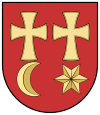Veľké Kapušany
| Veľké Kapušany | ||
|---|---|---|
| coat of arms | map | |

|
|
|
| Basic data | ||
| State : | Slovakia | |
| Kraj : | Košický kraj | |
| Okres : | Michalovce | |
| Region : | Dolný Zemplín | |
| Area : | 29.615 km² | |
| Residents : | 8,862 (Dec. 31, 2019) | |
| Population density : | 299 inhabitants per km² | |
| Height : | 113 m nm | |
| Postal code : | 079 01 | |
| Telephone code : | 0 59 | |
| Geographic location : | 48 ° 33 ' N , 22 ° 5' E | |
| License plate : | MI | |
| Kód obce : | 543853 | |
| structure | ||
| Community type : | city | |
| Urban area structure: | 2 districts | |
| Administration (as of November 2018) | ||
| Mayor : | Peter Petrikán | |
| Address: | Mestský úrad Veľké Kapušany L. N. Tolstého 1 07901 Veľké Kapušany |
|
| Website: | www.vkapusany.sk | |
| Statistics information on statistics.sk | ||
Veľké Kapušany (until 1927 Slovak also "Kapušany"; Hungarian Nagykapos ) is a city in the extreme east of Slovakia in the Eastern Slovakian Plain , near the border with Ukraine . It has a relatively high proportion of the Hungarian-speaking population.
General
The city lies on a flat plain in the eastern Slovakian lowlands between the Uh rivers in the north, the Laborec in the west and the Latorica in the south. The broad-gauge Uzhhorod – Košice line runs past the city and is important for the local economy, which mainly includes the wood processing, food and building materials industries. There are also a number of Slovak and Hungarian educational institutions.
Many poor Roma families are currently living in the many now unsightly new building blocks - remnants from communist times ; the other residents tend to settle on the outskirts in more modern houses.
Due to its rather insignificant historical role, there are relatively few sights in the place. Mention should be made of the baroque-classicist Reformed Tolerance Church from 1787 (rebuilt in 1922). Despite the relatively large Jewish community in town, there is no synagogue, but there is a badly damaged Jewish cemetery on the outskirts of the city.
history
The area of the city is an old settlement from the Neolithic Age and was founded as a wax settlement in the 11th and 12th centuries. The place was first mentioned in writing in 1211 as Kapos , in 1214 as Copus and in 1430 received city rights. The name of the place is derived from the Hungarian word kapu (German for "gate"). After Ungvár / Uschhorod, it was the second largest city in Ung County , to which it belonged in the Kingdom of Hungary , and very often served as a transit point or permanent settlement for people migrating from east to west (Germans, Russians, Poles, Hungarians and others).
After the First World War, the place fell to Czechoslovakia as part of Slovakia, but came back to Hungary from 1938 to 1945 through the First Vienna Arbitration . The invasion of the Germans in 1944 led to the persecution and deportation of the Jewish and Roma population living in the city, a memorial plaque on the market square commemorates this.
City structure
Officially, the city consists of the parts Veľké Kapušany and Veškovce (Hungarian Veskóc , incorporated in 1964). Čepeľ (Hungarian Ungcsepely ) and Malé Kapušany (Hungarian Kiskapos ) were incorporated in 1914.
Personalities
- János Erdélyi (1814–1868), Hungarian writer, philosopher and ethnographer
- Géza Gábor Herczegh (1928–2010), Hungarian lawyer


